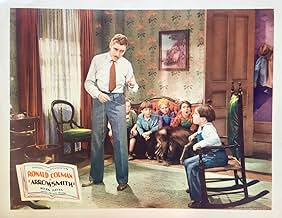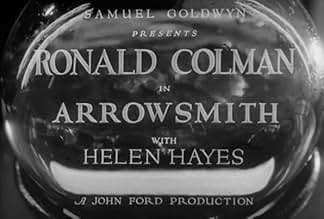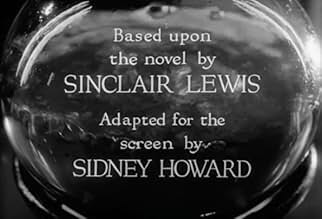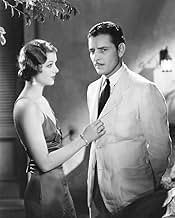CALIFICACIÓN DE IMDb
6.2/10
2.1 k
TU CALIFICACIÓN
Agrega una trama en tu idiomaA medical researcher is sent to a plague outbreak, where he has to decide priorities for the use of a vaccine.A medical researcher is sent to a plague outbreak, where he has to decide priorities for the use of a vaccine.A medical researcher is sent to a plague outbreak, where he has to decide priorities for the use of a vaccine.
- Dirección
- Guionistas
- Elenco
- Nominado a 4 premios Óscar
- 4 premios ganados y 4 nominaciones en total
Alec B. Francis
- Twyford
- (as Alec Francis)
Erville Alderson
- Pioneer
- (sin créditos)
Beulah Bondi
- Mrs. Tozer
- (sin créditos)
Florence Britton
- Miss Twyford
- (sin créditos)
Josephine Brown
- West Indies Village Bride
- (sin créditos)
Nora Cecil
- Nurse
- (sin créditos)
- Dirección
- Guionistas
- Todo el elenco y el equipo
- Producción, taquilla y más en IMDbPro
Opiniones destacadas
Based off the Lewis Sinclair epic, Arrowsmith follows a young doctor's journey as he explores different avenues of medicine and research. As you might expect, from page-to-screen, a little ends up on the cutting room floor. Still, if you like medical movies, you'll probably want to give this classic a try. It reminded me of a cross between The Citadel and The Doctor and the Girl.
As I've frequently said, there are two sides to Ronald Colman, and Arrowsmith contains the version with a stick perpetually lodged somewhere uncomfortable. He's not as passionate as he is in other movies, so keep that in mind. For a better first impression of him, try A Tale of Two Cities. You'll get a fine first impression of Helen Hayes, though, who plays his long-suffering wife. She's young and pretty in this one, a far cry from her Miss Marple little-old-lady persona of later decades. She has more passion than her husband, and she repeatedly pushes him to pursue his medical interest, even at the expense of their personal life. She never wants to be left behind, and she follows him all around the world as he conducts research for the bubonic plague.
You'll see Myrna Loy for about five minutes, but it's not her movie, so don't expect anything other than a pretty face. Colman and Hayes have pretty faces, too, and it is always fun to see a very old movie, but it's not my favorite. I like The Doctor and the Girl better, so if you find this movie lacking, you might want to check out Glenn Ford's take on it.
As I've frequently said, there are two sides to Ronald Colman, and Arrowsmith contains the version with a stick perpetually lodged somewhere uncomfortable. He's not as passionate as he is in other movies, so keep that in mind. For a better first impression of him, try A Tale of Two Cities. You'll get a fine first impression of Helen Hayes, though, who plays his long-suffering wife. She's young and pretty in this one, a far cry from her Miss Marple little-old-lady persona of later decades. She has more passion than her husband, and she repeatedly pushes him to pursue his medical interest, even at the expense of their personal life. She never wants to be left behind, and she follows him all around the world as he conducts research for the bubonic plague.
You'll see Myrna Loy for about five minutes, but it's not her movie, so don't expect anything other than a pretty face. Colman and Hayes have pretty faces, too, and it is always fun to see a very old movie, but it's not my favorite. I like The Doctor and the Girl better, so if you find this movie lacking, you might want to check out Glenn Ford's take on it.
Although the film has not aged well, "Arrowsmith" was well regarded when it was released and garnered four Academy Award nominations including Best Picture. Perhaps in those early days of sound, competent use of the camera and decent recording equipment were regarded as high values that merited praise. However, with the exception of some occasionally striking cinematography by Ray June, this John Ford adaptation of the Sinclair Lewis novel is choppy, unevenly acted, and betrays its age.
Later in the 1930's, Sidney Howard adapted the sprawling historical novel "Gone with the Wind" into a fine screenplay that left viewers with the feeling that they had seen the entire book on screen. However, his adaptation of the Pulitzer Prize Winning "Arrowsmith" omits the core message of the novel and rushes through events in the life of Dr. Martin Arrowsmith in brief vignettes that leave viewers confused. Characters appear and disappear, decisions and moves are made without deliberation or motivation, and Arrowsmith himself comes off as a shallow individual with little regard for either those he supposedly loves or those he supposedly has dedicated his life to saving.
Ronald Colman is generally a fine actor, and his idealism in "Lost Horizon" appeared genuine. However, Colman's suggested idealistic behavior in "Arrowsmith" is not convincing, despite a few effective scenes towards the end of the film. Helen Hayes has a few good scenes as the doctor's wife, although Myrna Loy has little to do but look seductive, which she does quite well.
Unfortunately, the scenes in the Caribbean seem demeaning to the characters, and a local doctor's willingness to allow what is effectively experimentation on his fellow countrymen borders on the criminal. However, these attitudes were considered the norm when the film was made and should be viewed in the context of the period. Although most films seem far too long, "Arrowsmith" is much too short to convey the canvas that Lewis painted in his novel. Almost like a Clift Notes version of the book, John Ford's "Arrowsmith" disappoints, especially when the talent expended on its production is considered.
Later in the 1930's, Sidney Howard adapted the sprawling historical novel "Gone with the Wind" into a fine screenplay that left viewers with the feeling that they had seen the entire book on screen. However, his adaptation of the Pulitzer Prize Winning "Arrowsmith" omits the core message of the novel and rushes through events in the life of Dr. Martin Arrowsmith in brief vignettes that leave viewers confused. Characters appear and disappear, decisions and moves are made without deliberation or motivation, and Arrowsmith himself comes off as a shallow individual with little regard for either those he supposedly loves or those he supposedly has dedicated his life to saving.
Ronald Colman is generally a fine actor, and his idealism in "Lost Horizon" appeared genuine. However, Colman's suggested idealistic behavior in "Arrowsmith" is not convincing, despite a few effective scenes towards the end of the film. Helen Hayes has a few good scenes as the doctor's wife, although Myrna Loy has little to do but look seductive, which she does quite well.
Unfortunately, the scenes in the Caribbean seem demeaning to the characters, and a local doctor's willingness to allow what is effectively experimentation on his fellow countrymen borders on the criminal. However, these attitudes were considered the norm when the film was made and should be viewed in the context of the period. Although most films seem far too long, "Arrowsmith" is much too short to convey the canvas that Lewis painted in his novel. Almost like a Clift Notes version of the book, John Ford's "Arrowsmith" disappoints, especially when the talent expended on its production is considered.
The student of medical school Martin Arrowsmith (Ronald Colman) dreams on becoming a researcher. He seeks out Professor Max Gottlieb (A.E. Anson) that promises the position when Arrowsmith is an undergraduate doctor. Meanwhile Arrowsmith meets the nurse Leora (Helen Hayes) and they fall in love with each other. When Prof. Gottlieb invites Arrowsmith to work with him in New York, he declines since the salary is not enough to support Leora and him. He marries Leora and becomes a countryside doctor. After a while, the frustrated Arrowsmith decides to move with Leora to New York to work with Gottlieb. Soon he is invited to go to a Caribbean Island where there is an outbreak of bubonic plague to test a serum he has developed in the population and Leora decides to go with him despite the danger. Will Arrowsmith succeed in saving the inhabitants?
"Arrowsmith" is a deceptive film directed by John Ford. The story seems to be incomplete missing explanation, for example, about Mrs. Joyce Lanyon, performed by the gorgeous Myrna Loy. The relationship between Arrowsmith and his wife is also underdeveloped. Ronald Colman is too old for the role of a young idealistic doctor. Maybe the viewer that has read the novel may like this film more than one that has never read it. Last but not the least, the Brazilian title is awful. My vote is five.
Title (Brazil): "Médico e Amante" ("Doctor and Lover")
"Arrowsmith" is a deceptive film directed by John Ford. The story seems to be incomplete missing explanation, for example, about Mrs. Joyce Lanyon, performed by the gorgeous Myrna Loy. The relationship between Arrowsmith and his wife is also underdeveloped. Ronald Colman is too old for the role of a young idealistic doctor. Maybe the viewer that has read the novel may like this film more than one that has never read it. Last but not the least, the Brazilian title is awful. My vote is five.
Title (Brazil): "Médico e Amante" ("Doctor and Lover")
The fact that an idealistic medical doctor was the protagonist in Arrowsmith is the reason why John Ford must have been attracted to this story and agreed to film it for Sam Goldwyn.
Allegedly it was not a happy collaboration. Two very individualistic men wanted to have their imprimatur on the film. They never worked together on a finished product again, though Ford did start filming The Adventures of Marco Polo for Goldwyn and quit.
I read the novel way back in the day when I was in high school and we only get the second half of it. There's a great deal in the book before Ronald Colman as Martin Arrowsmith goes to work for the Research Foundation and A.E. Anson as Max Gottlieb. You miss quite a lot of the character development of Arrowsmith.
Of course the plot mostly centers on Colman and his other mentor, Richard Bennett going to a Caribbean Island where there has been an outbreak of plague. Along for the trip is Helen Hayes who is Colman's wife Leora.
Colman is there to test a new serum and he's under orders as a researcher to only administer the real stuff to half his patient and a placebo to the others as a control group. This is where the racism of the time kicks in as these human guinea pigs are black, probably the descendants of runaway slaves. There is a black doctor named Marchand in the cast played by Oliver Brooks and it is a rarity among black performers at the time in that the role was hardly servile at all. Brooks seems to go along with the controlled experiment, but he becomes one of many in the cast to meet a tragic end.
With some of what came out about the Tuskegee experiments later on Arrowsmith may have been quite on target without knowing it. A harrowing thought.
Colman and Hayes are an attractive pair of leads. Myrna Loy has a much abbreviated role in the film as a New York socialite that Colman meets down in the islands. In the book he has an affair with her and marries her later on. You won't see that here.
Arrowsmith is a good film though I wish more of Lewis's story got into the final product. But it probably would have run for three hours and films just didn't do that back then.
Allegedly it was not a happy collaboration. Two very individualistic men wanted to have their imprimatur on the film. They never worked together on a finished product again, though Ford did start filming The Adventures of Marco Polo for Goldwyn and quit.
I read the novel way back in the day when I was in high school and we only get the second half of it. There's a great deal in the book before Ronald Colman as Martin Arrowsmith goes to work for the Research Foundation and A.E. Anson as Max Gottlieb. You miss quite a lot of the character development of Arrowsmith.
Of course the plot mostly centers on Colman and his other mentor, Richard Bennett going to a Caribbean Island where there has been an outbreak of plague. Along for the trip is Helen Hayes who is Colman's wife Leora.
Colman is there to test a new serum and he's under orders as a researcher to only administer the real stuff to half his patient and a placebo to the others as a control group. This is where the racism of the time kicks in as these human guinea pigs are black, probably the descendants of runaway slaves. There is a black doctor named Marchand in the cast played by Oliver Brooks and it is a rarity among black performers at the time in that the role was hardly servile at all. Brooks seems to go along with the controlled experiment, but he becomes one of many in the cast to meet a tragic end.
With some of what came out about the Tuskegee experiments later on Arrowsmith may have been quite on target without knowing it. A harrowing thought.
Colman and Hayes are an attractive pair of leads. Myrna Loy has a much abbreviated role in the film as a New York socialite that Colman meets down in the islands. In the book he has an affair with her and marries her later on. You won't see that here.
Arrowsmith is a good film though I wish more of Lewis's story got into the final product. But it probably would have run for three hours and films just didn't do that back then.
Goldwyn put together a lot of fine talent here, but none of it jells.
Ronald Colman, Laurence Olivier's idol and one of the screen's most likable actors, is just plain miscast. Helen Hayes projects annoyingly to the audience, stage fashion, rather than letting the camera discover her emotions, as even the young Myrna Loy knows how to do. Richard Bennett is enjoyably over-the-top as Sondelius but A. E. Anson's accent is a deal-breaker as Gottlieb (as if there weren't enough real Middle European actors in Hollywood at the time).
Sydney Howard's script is condensed to the point of silliness - the other reviewers here who contrast "Gone With the Wind" as a model of condensation are praising an uncredited Ben Hecht, not Sydney Howard. Ray June's fluid cinematography is beautiful throughout, with more than one shot that would wind up re-used in Ford's "The Searchers" many years later.
The story is that Goldwyn hired a bibulous Ford on condition that the director couldn't take one drink during production. Helen Hayes noticed that as the shoot progressed, Ford started discarding pages and then whole scenes, in a race to finish the film and get back to his booze. That may be one more reason that the film is barely coherent.
Hey, nobody's perfect all the time.
Ronald Colman, Laurence Olivier's idol and one of the screen's most likable actors, is just plain miscast. Helen Hayes projects annoyingly to the audience, stage fashion, rather than letting the camera discover her emotions, as even the young Myrna Loy knows how to do. Richard Bennett is enjoyably over-the-top as Sondelius but A. E. Anson's accent is a deal-breaker as Gottlieb (as if there weren't enough real Middle European actors in Hollywood at the time).
Sydney Howard's script is condensed to the point of silliness - the other reviewers here who contrast "Gone With the Wind" as a model of condensation are praising an uncredited Ben Hecht, not Sydney Howard. Ray June's fluid cinematography is beautiful throughout, with more than one shot that would wind up re-used in Ford's "The Searchers" many years later.
The story is that Goldwyn hired a bibulous Ford on condition that the director couldn't take one drink during production. Helen Hayes noticed that as the shoot progressed, Ford started discarding pages and then whole scenes, in a race to finish the film and get back to his booze. That may be one more reason that the film is barely coherent.
Hey, nobody's perfect all the time.
¿Sabías que…?
- TriviaCensorship at the time meant that the subplot of Arrowsmith's liaison with another woman while still married meant that most of Myrna Loy's scenes were drastically cut. Although every attempt was made to restore the present version to its original length, there are still about 10 minutes missing.
- ErroresArrowsmith conducts a trial of his serum by giving it to half the potential plague victims and giving the other half nothing. Anyone who tried this in real life would provoke protests, if not riots. So these trials are conducted by giving half the people a placebo and not telling anyone which they are getting.
- Citas
Dr. Martin Arrowsmith: God give me clear eyes and freedom from haste. God give me anger against all pretense. God keep me looking for my own mistakes. God keep me at it till my results are proven. God give me strength not to trust to God.
- Créditos curiososOpening credits prologue: The story of a man who dedicated his life to service and his heart to the love of one woman.
- Versiones alternativasMyrna Loy's role was substantially reduced when the film was reissued because the Production Code had taken effect. The missing scenes have been restored on the DVD.
- ConexionesReferenced in El Ciudadano Kane (1941)
- Bandas sonorasWilliam Tell Overture
(1829) (uncredited)
Written by Gioachino Rossini
Played on piano from a recording
Selecciones populares
Inicia sesión para calificar y agrega a la lista de videos para obtener recomendaciones personalizadas
- How long is Arrowsmith?Con tecnología de Alexa
Detalles
- Tiempo de ejecución1 hora 48 minutos
- Color
- Relación de aspecto
- 1.20 : 1
Contribuir a esta página
Sugiere una edición o agrega el contenido que falta

Principales brechas de datos
What is the Spanish language plot outline for Arrowsmith (1931)?
Responda



































